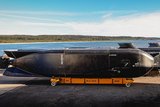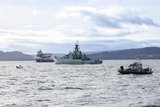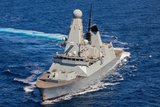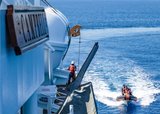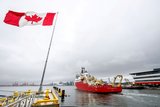Emirati and Israeli companies pledge joint USV development
Pictured (left to right): Boaz Levy, IAI president and CEO; Yehuda Lahav, EVP Marketing IAI; David Massey, CEO ADSB; and Faisal Al Bannai, EDGE CEO and MD. (Photo: IAI)
EDGE on 18 November announced an agreement with Israel Aerospace Industries (IAI) to conduct joint development of ‘a first-in-class series of 17m unmanned surface vessels (USVs) for the entire range of military and commercial applications’, the defence conglomerate noted in a statement.
EDGE added that its Abu Dhabi Ship Building subsidiary will design the platform, integrate the control systems and payload and develop the CONOPS for this new family of USVs, while IAI will develop the autonomous control system and integrate various mission payloads according to specific mission requirements.
IAI may leverage its experience in developing the optionally crewed 11.9m-long Katana USV, which it unveiled in early 2014. In the aftermath of the Abraham Accords which normalised relations between Israel and the UAE, Shephard reported that USVs could prove a fruitful area of defence industrial collaboration between the two countries.
In the future UAE-made design, advanced sensors, sonars and imaging systems will be integrated into a unified C2 system with AI algorithms, so that the bespoke USV can operate either remotely, semi-autonomously or autonomously.
Military applications for the USV would include ISR, border and littoral zone patrol, maritime security, mine detection and sweeping, submarine detection and anti-submarine warfare, EDGE stated.
EDGE CEO Faisal Al Bannai emphasised the importance of collaborating with companies such as IAI ‘to strengthen our advanced technology portfolio’, while also opening ‘many doors for us in local and global markets, military and commercial alike’.
More from Naval Warfare
-
![MBDA-led DragonFire’s latest trials move the LDEW system closer to UK Navy integration]()
MBDA-led DragonFire’s latest trials move the LDEW system closer to UK Navy integration
The DragonFire lines up with other European laser-directed energy weapons being developed in collaboration with MBDA.
-
![US Coast Guard pursues solutions to increase maritime domain dominance]()
US Coast Guard pursues solutions to increase maritime domain dominance
The USCG is seeking technologies, services and applications to better connect its assets and speed up the decision-making process.
-
![Canadian Coast Guard’s OOSV delivery is “major milestone” in fleet modernisation]()
Canadian Coast Guard’s OOSV delivery is “major milestone” in fleet modernisation
The Polar Class 6 platform is the largest CCG science-dedicated vessel and will operate on the country’s east coast.








